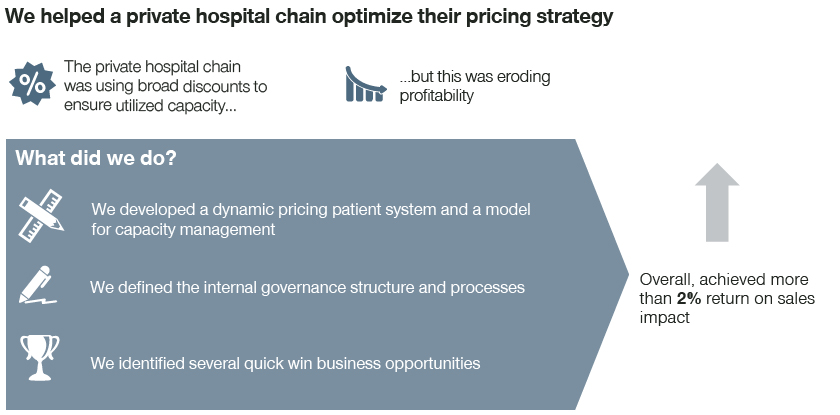In Part 1 of our four-part series, we outlined the importance for private hospitals to improve their self-pay offering. However, without the right healthcare pricing strategy private hospitals are at risk of failing to capture the true value of their offering. In Part 2, our experts outline the three steps required to reach pricing excellence when providing self-pay services.
Self-pay services in private healthcare are gaining popularity among patients. However, with more patients willing to pay out-of-pocket for healthcare services, understanding what price to set is crucial.
Without such an effective pricing strategy, the efforts private hospitals put into improving their self-pay offering (as outlined in Part 1) cannot be realized.
Pricing excellence: What opportunities exist for private hospitals?
The main challenge for private hospitals when it comes to pricing self-pay services is the absence of a systematic approach. Pricing decisions are often based on legacy or gut feeling rather than strategy and facts. This means stakeholders use their intuition and historic price lists without critically reflecting on patient value and current market dynamics.
Such issues are complicated further when more sites are added to the hospital group (e.g., through mergers and acquisitions). This usually means that branches are left to their own processes, relying on local capabilities and interests in pricing and profitability. Private hospitals find themselves competing against their own sites and fail to share best practices.
The result? They end up harming growth. That’s why introducing transparency and structure in self-pay pricing provides a great opportunity for immediate and sustainable positive business impact.
Due to the lack of a clear self-pay pricing strategy, price levels are neither aligned with the value that the procedure and the provider deliver nor are they reflective of the local differences across sites.
A higher self-pay price may be deemed feasible for certain times to align with demand (e.g., season, weekdays), or for certain sites with more modern facilities and less competition. Therefore, value-based pricing and a clever price differentiation provides an opportunity for private hospitals to capture the full value of their offering and skim the willingness to pay (WTP) of different patient segments.
Three steps to pricing excellence for self-pay services
- Set up a central pricing function
“Who should be in the driver’s seat for setting and monitoring prices?” The answer is clear: Self-pay pricing has to be top-of-mind for all commercial leaders of private hospitals and needs a dedicated function.
Only a central pricing function can establish an overall pricing strategy and framework that:
- Supports your business objectives
- Overcomes inefficiencies and ineffectiveness
- Enables continuous improvement on pricing
Even if profit and loss responsibility lies with hospital directors of individual sites, the central pricing function can be a valuable sparring partner for price monitoring, price setting, and best-practice sharing.
- Reveal the pricing status quo
The start of any price optimization is transparency: What are your current price levels? Are there differences across sites and why? What has been the impact of historic price changes, price promotions, and marketing activities?
A hypothesis-driven pricing audit investigates the current state of the private hospital’s pricing strategy, setting, and execution in a targeted manner. It also allows to capture inconsistencies, quick win opportunities, and long-term improvement areas. Also, private hospitals can greatly optimize their self-pay healthcare prices by leveraging FHIR solutions.
- Understand what drives value
The next step is to develop a price model that is value-based and futureproof. To do this, you need to understand what drives patient value. Conducting a thorough analysis of transaction data can give valuable insights on patients’ price sensitivity.
Leveraging customer satisfaction surveys (e.g., net promoter score) and running dedicated market research give direct insights into patient value perception, value drivers and WTP. Beyond that, you need to base value and price positioning on multiple internal and external factors like price transparency and uniqueness of the service.
In addition, with elective treatments there’s opportunity to establish informed revenue management that reflects capacity and utilization. For example, you might want to offer a discount to incentivize patients to select a certain day. Such strategies ensure the use of available capacity and reduce waste. This will also help you set pricing based on the popularity of particular times and dates.
In order to benefit from an upgraded price model in the long run, the central pricing function needs to continuously monitor and review price performance. This process can be supported by a Price Optimization & Management (PO&M) tool that greatly facilitates setting and managing list prices, discounts, approval levels, and margin thresholds. In Part 3 of our series, we’ll go into more detail on how to standardize and digitalize your pricing and quoting process.
How we’ve helped

If you would like more information on how to provide optimal self-pay services, reach out to our experts!
________
Read more from our series:
Part 1: How Private Hospitals can Optimize their Self-Pay Healthcare Offering
Part 3: How Private Hospitals can Grow Self-Pay Business via a Streamlined Sales Process
Part 4: How Private Hospitals can Execute Change Management Successfully








